Washington D.C.
Yes, that unassuming piece of dog excrement could just be a radio transmitter. The photo above features one of the items espionage agencies really used in their daily lives, James Bond’s Q notwithstanding. This 1970s artifact is just one of many “spy tools” on display at the International Spy Museum. Your visit starts at the Adams Building, the small building’s appearance is its own “spy story”. The museum is much larger than the small building front would appear. Just around the block from Ford’s Theatre, I was sceptical that the museum might just be a way to separate a tourist from some travel funds. Though the privately owned museum isn’t inexpensive, a person could spend much more at a theater watching a spy thriller and munching on those expensive treats. So maybe you don’t get the expensive treats (or their unnecessary calories), you will see many exhibits featuring tools of real spies, view artifacts of movie spies and even participate in Spy Training School or go on a one-hour spy adventure. More information on the Spy Museum can be found here.
Your visit starts at the Adams Building, the small building’s appearance is its own “spy story”. The museum is much larger than the small building front would appear. Just around the block from Ford’s Theatre, I was sceptical that the museum might just be a way to separate a tourist from some travel funds. Though the privately owned museum isn’t inexpensive, a person could spend much more at a theater watching a spy thriller and munching on those expensive treats. So maybe you don’t get the expensive treats (or their unnecessary calories), you will see many exhibits featuring tools of real spies, view artifacts of movie spies and even participate in Spy Training School or go on a one-hour spy adventure. More information on the Spy Museum can be found here.
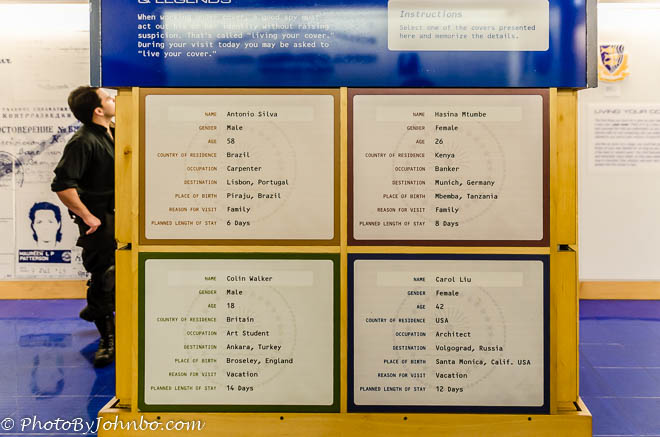 After purchasing our senior tickets ($16 each), my wife Lynn, and I rode an elevator to a small waiting area where we were given the opportunity to pick a secret identity. This activity is optional, but we decided to play along. I chose the identity of Antonio Silva, a 58 year-old carpenter from Brazil. It would be my job to learn and remember my itinerary details. After all, I would be interrogated. I grabbed a quick snapshot of the ID on my cell phone and hoped I wouldn’t be tortured to give up the phone where my secret would be easily discovered.
After purchasing our senior tickets ($16 each), my wife Lynn, and I rode an elevator to a small waiting area where we were given the opportunity to pick a secret identity. This activity is optional, but we decided to play along. I chose the identity of Antonio Silva, a 58 year-old carpenter from Brazil. It would be my job to learn and remember my itinerary details. After all, I would be interrogated. I grabbed a quick snapshot of the ID on my cell phone and hoped I wouldn’t be tortured to give up the phone where my secret would be easily discovered.
The first set of exhibits we viewed features a School for Spies. The school teaches some basic techniques of observation and behavior that all spies need to know. The interactive displays were at once interesting and informative. I found myself crawling through a ventilation duct being as quiet as possible. Noise picked up by security microphones would give my presence away. I successfully navigated the ductwork to find myself in the historical archives of espionage equipment. Or, you could simply walk over to the archives. No need to climb through ductwork.
There are many items on display in the archives. The tiny camera in the photo above is normally disguised inside a fancy cigarette case complete with fake cigarette top. More photos of the archive are included in the gallery of images that accompany this post.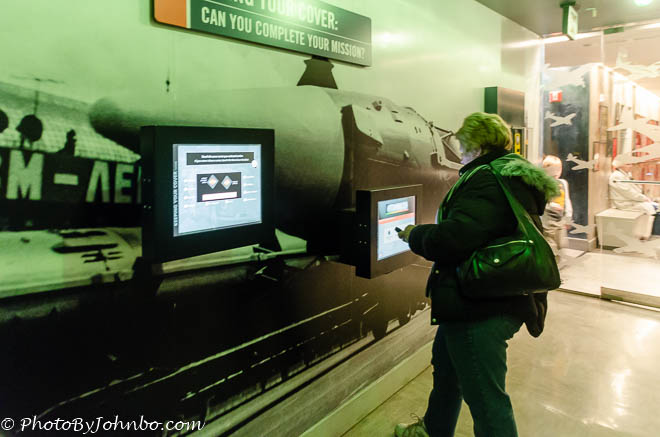 Along the way, interactive kiosks are available that “demand” your credentials. It’s time to put on your spy hat and adopt your secret identity. You will be quizzed as to the purpose of your visit and other details that you should have remembered in spy school. Again, participation is voluntary. In the photo above, Lynn is being interrogated.
Along the way, interactive kiosks are available that “demand” your credentials. It’s time to put on your spy hat and adopt your secret identity. You will be quizzed as to the purpose of your visit and other details that you should have remembered in spy school. Again, participation is voluntary. In the photo above, Lynn is being interrogated.
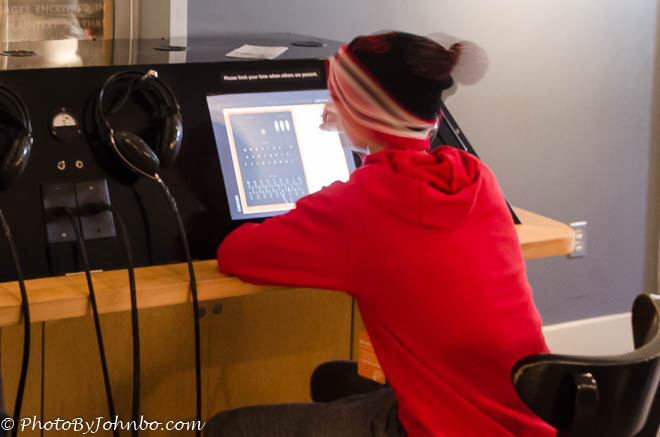 In a dimly lit room dedicated entirely to the German World War II message coding device, the Enigma, visitors are given an interactive demonstration as to how messages were coded and decoded by the device. The Germans never knew that the allies had broken the code. Credit is given to Alan Turing and a team of British mathematicians for breaking the code, however in recent years, a trio of Polish cryptologists are being given credit for their work as well.
In a dimly lit room dedicated entirely to the German World War II message coding device, the Enigma, visitors are given an interactive demonstration as to how messages were coded and decoded by the device. The Germans never knew that the allies had broken the code. Credit is given to Alan Turing and a team of British mathematicians for breaking the code, however in recent years, a trio of Polish cryptologists are being given credit for their work as well.
 The museum isn’t all history and exhibits. The hands-on games are entertaining for young and old alike. The device in the photo above tests the would-be spy’s ability to “hang in there” holding onto a pipe as it moves upward. It takes a strong grip to make the trip all the way to the top. In the few minutes that Lynn and I watched, no one made it to the top before their hands gave up their grip and the fledgling spy would fall to a mat below.
The museum isn’t all history and exhibits. The hands-on games are entertaining for young and old alike. The device in the photo above tests the would-be spy’s ability to “hang in there” holding onto a pipe as it moves upward. It takes a strong grip to make the trip all the way to the top. In the few minutes that Lynn and I watched, no one made it to the top before their hands gave up their grip and the fledgling spy would fall to a mat below.
As you can see in the photo above, we came within one-second of destroying the world. You can thank me. After pushing the red button on the top, the “bomb” is armed and the clock starts counting down to zero. I had but a few seconds to twist the handle on the fusing device and pull it out carefully so that the cylinder did not touch the housing. Failing to pull the fuse up straight and true in the allotted time would set off the bomb. This exhibit, and many others, were featured in a section of the museum dedicated to the movie spy. Clips from many spy thrillers are featured, along with artifacts from the movie productions. One bit of trivia I learned in this section is that Ian Fleming, author of the James Bond series, also wrote Chitty Chitty Bang Bang.
The last stop on the museum tour is another set of kiosks where you can be questioned as to your identity and the purpose of your trip. Don’t get it wrong. I was allowed to leave, however Lynn was detained, tripped up by a single wrong answer. Don’t let it happen to you! The gallery of images below features some of the exhibits we viewed at the museum. Click on an image to enlarge it and to scroll through the gallery.
John Steiner


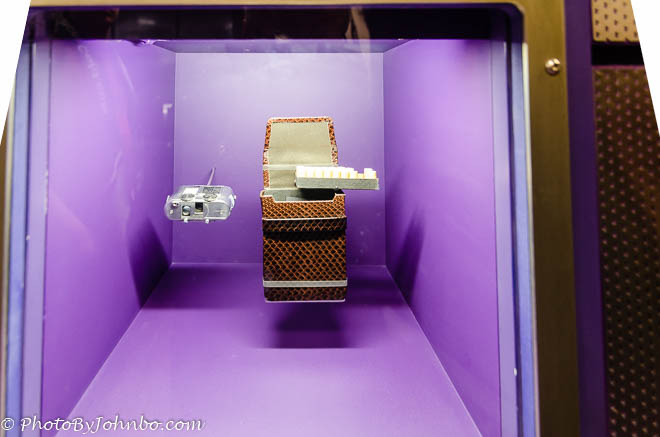
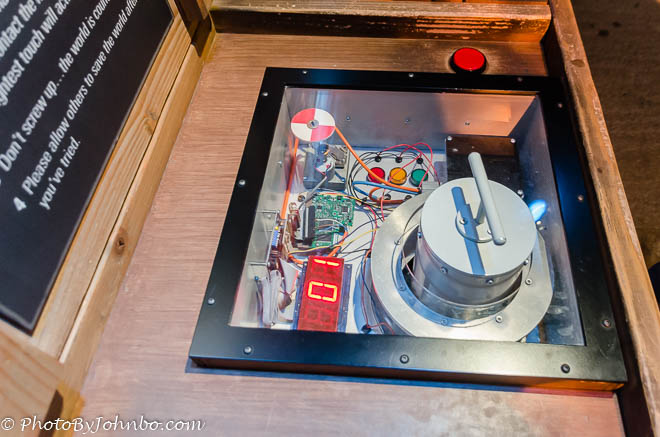















Nice pictures! We went to the spy museum last year. It was so fascinating!
Thanks. It was more fun that I thought it might be.
So cool you guys went here! We never went frankly because there were so many free exhibits via the Smithsonian, we didn’t want to fork over the money. LOL Nothing ventured, nothing gained. 😉